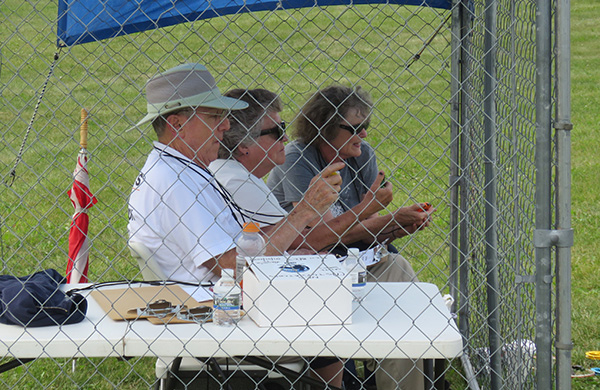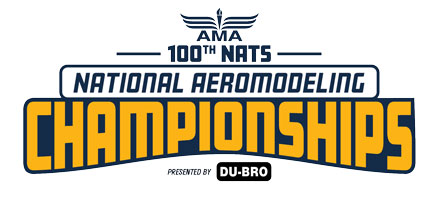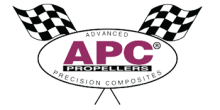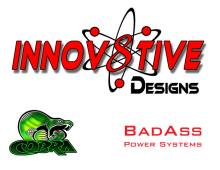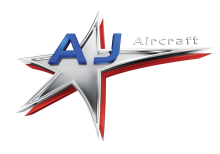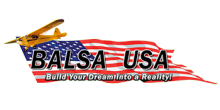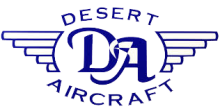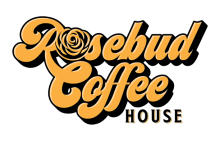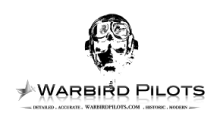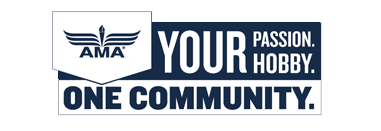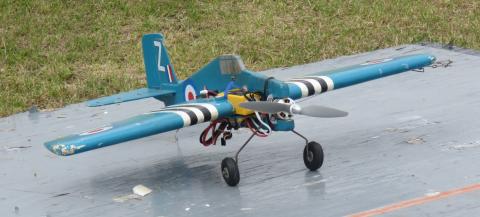
This carrier plane landed short of the deck.
By Melvin Schuette
The Navy Carrier event came about during the time that the US Navy sponsored the Nationals and they wanted an event with a Navy theme. These events consist of three separate sections, High Speed, Low-Speed, and Landing. Contestants are given three attempts to make two official flights. A flight becomes an official flight when the contestant signals the judges before the start of their low-speed flight.
The first is High Speed. The Navy Carrier events use a simulated carrier ship to take off from and land on. The plane is timed from the moment of release until the completion of seven laps (1/2 mile) as fast as you can. Then, the throttle is reduced using either a mechanical method (a three-line bellcrank and handle) or the use of a 2.4GHz radio and receiver.
After the contestant has slowed the model down, they must signal the judges. Their low-speed portion of the flight will start the next time the model crosses the stern of the deck. The contestant then flies seven laps as slowly as they can. A model cannot exceed a sixty-degree nose high attitude during low speed. If the model exceeds the sixty-degree angle, other than momentarily, the modeler is given a warning. The contestant can receive up to three warnings, the fourth warning results in a zero score for the low-speed portion of the flight and landing.
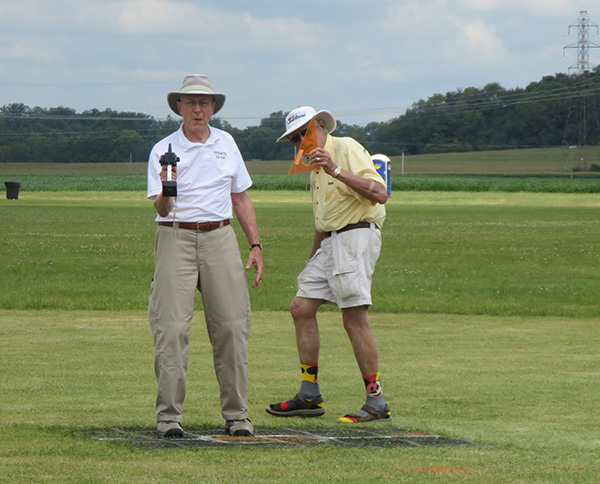
After completion of Low Speed, the contestant must signal the judges as the model crosses the stern of the deck. They do this one lap before attempting to make an arrested landing on the back half of the same deck they took off from.
The contestant will receive one point for every mile per hour of low speed. They are scored ten times the ratio between the high speed and the low-speed portions of the flight. The landing scores 100 points if the plane makes an arrested landing on its first attempt. Five points is deducted for each additional lap if the plane misses making an arrested landing on the first attempt. Points can also be deducted if the plane makes an arrested landing and ends up in anything other than a normal 3-point position.
If any part of the model touches the ground during any portion of the flight, they will receive a zero score for that portion of the flight and any portion of the flight after that. The carrier deck has a ramp attached to the stern of the deck. Touching the ramp during any part of the flight is the same as touching the ground
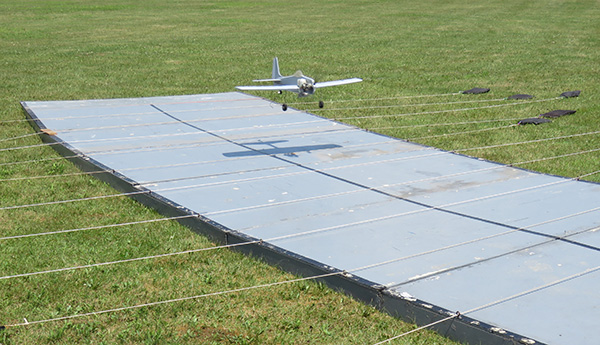
The contestant will also receive scale bonus points if their model qualifies. To receive scale bonus points, the model must be a replica of an airplane that actually made an arrested landing on a carrier ship, or was designated for carrier use by an acceptable source.
There are a total of six official Navy Carrier events, which are divided into two categories: Electric motor-powered aircraft and internal combustion engine powered aircraft. Each category is divided into three classes. Profile, Class I, and Class II. Profile models are eligible for 10 scale bonus points. Class I & II models will receive 100 points if the model is within 5% of the scale outline.
The processing of all of the Carrier events will be held on Monday, July 7th, with competition starting on Tuesday July 8th. The official Profile Electric and Internal Combustion-powered events will be held on Tuesday the 8th. All of the official Class I & II events will be held on Wednesday July 9th.
Thursday, July 10th is the date scheduled for the unofficial Navy Carrier events. The events that will be held are 15 Profile Carrier, Sig Skyray 35 Carrier, Profile Nostalgia Carrier, and Class I and II Nostalgia Carrier.
The Navy Carrier Society, (the official Special Interest Group representing the Navy Carrier events) awards the Eugene Ely Award each year. This awarded is given to the contestant that has the highest combined score in one of the official Profile classes, one of the official Class I classes, and one of the official Class II classes. Before the competition starts, each contestant must declare what class scores they want to use towards the Eugene Ely award.
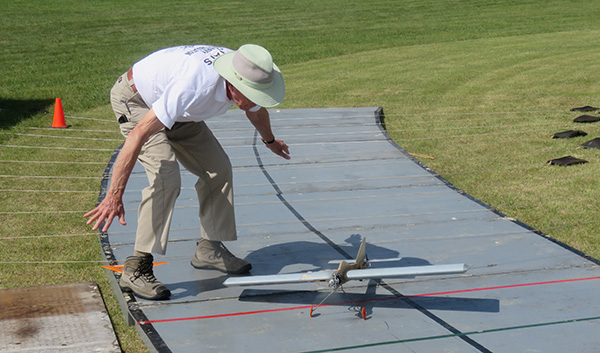
The Navy Carrier Society also awards the Carol Johnson Spirit of Volunteerism Award. The award is named in honor of Carol Johnson, who spent many a nationals timing and helping out wherever she was needed until her untimely passing. The award is given to the person the Navy Carrier Society feels best represents the spirit of the award.
Currently there are no commercially made Control Line handles that have an integrated radio. Those who use an R/C car radio to control the throttle and other functions on a Carrier model do it one of two ways. One way is to hold the handle in one hand and the radio in the other hand. Most of the contestants using radios have modified the R/C car radios so they are mounted to the top of a handle, so that only one hand is required to control the model.
At the Nationals in 2024, a prototype of the Linemaster 2.4GHz handle was shown. It is a purpose-built control line handle with an integrated R/C system. There will be two versions of the unit available. Both versions will be available for use either left or right-handed. The first is a one-channel unit that is used for throttle only. The second is a ten-channel unit that has toggle switches and rotary switches to control the functions.
All radios will have multiple model capabilities. You will be able to change the bar on the front of the handle, so you won’t have to readjust neutral every time you change planes. At the time of this writing, an exact release date and the final cost has not been yet been determined.
